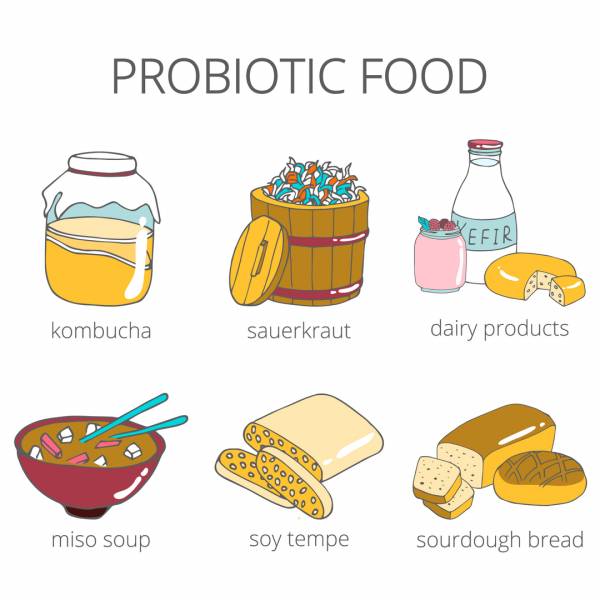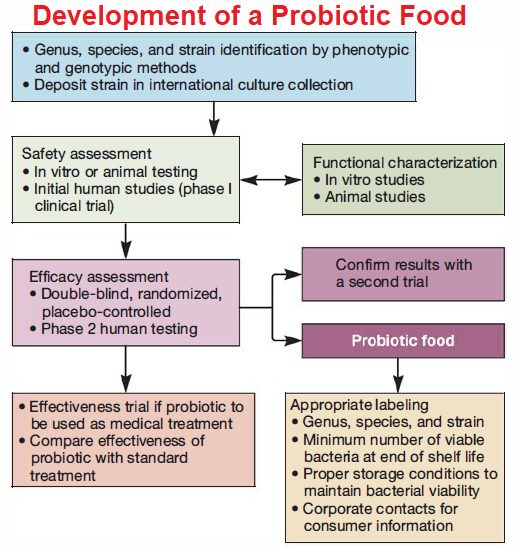Probiotics
What are probiotics?
The health benefits of fermented foods such as yogurt, which commonly contain bacteria in the genera Lactobacillus and Bifidobacterium, have been touted for many years. Recent advances in understanding the human gut microbiome have demonstrated that specific microbial products, often attributed to these bacteria, have a profound influence on immune system function.
The lactobacilli and bifidobacteria have been shown to stimulate immune maturation and minimize inflammation. Other health benefits attributed to the consumption of fermented milks involve minimizing lactose intolerance, lowering serum cholesterol, and possibly protecting against colon cancer.

Several lactobacilli have antitumor compounds in their cell walls. While these “good” bacteria cannot numerically overtake entrenched gut microflora, they have been shown to change the metabolism of other microorganisms in the gut, such that sugars from fruits and vegetables are more thoroughly catabolized.
With all the media attention probiotic foods receive, consumers should know that the term “probiotic” is not regulated. In an effort to standardize the use of the term probiotic, the Food and Agricultural Organization of the United Nations-World Health Organization (FAO-WHO) has defined it as “live microorganisms, which, when administered in adequate amounts, confer a health benefit to the host:’ FAO-WHO guidelines published in 2002 provide specific requirements that should be met for products to meet this standard.

How probiotics used in agriculture?
Probiotic microbes are also used to promote the health of farm animals. Such microbes, primarily Lactobacillus acidophilus, are used in beef cattle feed. When the bacteria are sprayed on feed, the cattle that eat it appear to have markedly lower (as much as 60%) carriage of the pathogenic E. coli strain 0157:H7.
This can make it easier to produce beef that will meet current standards for microbiological quality at the time of slaughter. Probiotics are also used successfully with poultry. For instance, the USDA has designated a probiotic Bacillus strain for use with chickens as GRAS (p. 963).
Feeding chickens a strain of Bacillus subtilis leads to increased body weight and feed conversion. There is also a reduction in coliforms and Campylobacter spp. in the processed carcasses. It has been suggested that this probiotic decreases the need for antibiotics in poultry production and pathogen levels on farms.
Salmonella enterica can be controlled by spraying a patented blend of 29 bacteria, isolated from the chicken cecum, on day-old chickens. As they preen themselves, the chicks ingest the bacterial mixture, establishing a functional microbial community in the cecum and limiting Salmonella colonization of the gut in a process called competitive exclusion.
Reference and Sources
- https://www.researchgate.net/publication/329265427_Yogurt_and_other_fermented_foods_as_sources_of_healthpromoting_bacteria
- https://www.researchgate.net/publication/263972150_Pre-_and_postharvest_interventions_to_reduce_pathogen_contamination_in_the_US_beef_industry
- https://www.sciencedirect.com/science/article/pii/S1043466617301722
Also Read
- Nitrogen Cycle
- Microbial Fuel Cells
- The Genetic Code
- Anti protozoan Drugs
- Deoxyribonucleic acid (DNA)
- Polymerase Chain Reaction
- DNA replication in prokaryotes
- Measurements of microbial growth
- Biogeochemical Iron Cycle
- Microorganisms in Benthic Marine Environments
- Milk: Composition, Processing, Pasteurization, Pathogens and Spoilage
- Innate Immunity: Description, Functions and Facts
- Agglutination reaction: Definition, Uses and Application
- Antimicrobial activity of Mimosa pudica l
- CRISPR-Cas9 Gene editing tool: Introduction, Principles, Uses & Applications
- Xanthan gum: Introduction, Structure, applications and production
